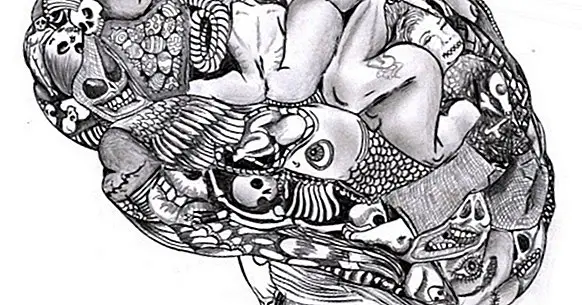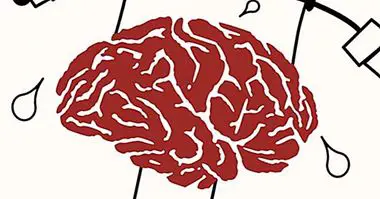Schizoaffective disorder: causes, symptoms and treatment
The Schizoaffective disorder It is a controversial disorder at the theoretical level, but a clinical reality that affects 0.3% of the population. Knowing their symptoms, effects and characteristics that can explain their causes is to know this diagnostic category.
What is Schizoaffective Disorder?
Broadly speaking, we can understand Schizoaffective Disorder as a mental disorder that combines psychotic symptoms (delusions, hallucinations, disorganized discourse, very disorganized behavior or negative symptoms such as diminished emotional expression or apathy) and mood disorders (mania -depression).
Thus, the Schizoaffective Disorder affects fundamentally emotional perception and psychological processes.
Symptoms and Diagnosis of Schizoaffective Disorder
The Schizoaffective Disorder is usually diagnosed during the period of psychotic illness, due to the complexity of its symptomatology. Episodes of depression or mania are present for most of the duration of the illness.
Due to the great variety of psychiatric and medical conditions that can be associated with psychotic symptoms and mood symptoms, in many occasions the schizoaffective disorder can be confused with other disorders, such as bipolar disorder with psychotic characteristics. , major depressive disorder with psychotic features ... In a way, the limits of this diagnostic category are confusing , and this is what causes a debate about whether it is an independent clinical entity or the coexistence of several disorders.
To distinguish it from other disorders (such as bipolar disorder), psychotic features, delusions or hallucinations must be present for at least 2 weeks in the absence of a major episode of mood (depressive or manic). Thus, the criterion that is used to distinguish between Schizoaffective Disorder and other types of mental disorders is, fundamentally, time (duration, frequency of appearance of symptoms, etc).
The difficulty in diagnosing this disorder lies in knowing if mood symptoms have been present during most of the total active and residual duration of the disease, determining when there were significant mood symptoms accompanied by psychotic symptoms. To know these data, the health professional must know exhaustively the clinical history of the subject .
Who suffers this type of psychopathology?
The prevalence of Schizoaffective Disorder in the population is 0.3%. It is estimated that its frequency is one third of the population affected by schizophrenia .
Its incidence is higher in the female population. This is mainly due to the higher incidence of depressive symptoms among women compared to men, something that may have genetic but also cultural and social causes.
When does it usually start to develop?
There is consensus in affirming that the age of onset of Schizoaffective Disorder usually occurs in early adult life, although this does not prevent it from occurring during adolescence or in the later stages of life.
In addition, there is a pattern of differentiated appearance according to the age of the person who begins to experience the symptoms. Bipolar disorder Schizoaffective disorder usually prevails in young adults, while Schizoaffective Depressive Disorder usually prevails in older adults.
How does Schizoaffective Disorder influence people who suffer it?
The way in which the Schizoaffective Disorder leaves a mark on the day to day of those who experience it has to do with practically all areas of life. But nevertheless, some main aspects can be highlighted :
- The ability to continue functioning at the work level is normally affected , although, unlike what happens with schizophrenia, this is not a determining factor as a defining criterion.
- Social contact is diminished for the Schizoaffective Disorder. The ability to self-care is also affected although, as in the previous cases, the symptoms are usually less severe and persistent than in schizophrenia.
- Anosognosia or absence of introspection it is common in Schizoaffective Disorder, being less severe than in schizophrenia.
- There is a possibility of being associated with alcohol-related disorders or other substances.
Forecast
Schizoaffective disorder usually has a better prognosis than schizophrenia. On the contrary, its forecast is usually worse than mood disorders , among other things because the symptoms related to the perception problems suppose a very abrupt qualitative change to what would be expected in a person without this disorder, while the alterations of the state of mind can be understood as a problem of rather quantitative type .
In general, the improvement that occurs is understood from a functional and neurological point of view. We can then place it in an intermediate position between the two.
A higher prevalence of psychotic symptoms, more chronicity of the disorder . The duration of the course of the disease also affects. The longer it lasts, the more chronic it is.
Treatment and psychotherapy
To date there are no tests or biological measures that can help us to diagnose Schizoaffective Disorder. There is no certainty as to whether there is a neurobiological basis difference between Schizoaffective Disorder and schizophrenia in terms of their associated characteristics (such as brain, structural or functional anomalies, cognitive deficits and genetic factors). Thus, In this case, planning highly effective therapies is very difficult .
The clinical intervention, therefore, focuses on the possibility of mitigating symptoms and training patients in the acceptance of new standards of life and management of their emotions and self-care and social behaviors.
For the pharmacological treatment of Schizoaffective Disorder, antipsychotics, antidepressants and mood stabilizers are usually used, while the psychotherapy of the Schizoaffective Disorder most indicated would be the cognitive-behavioral type. In order to implement this last action, the two pillars of the disorder must be treated.
- On the one hand, the treatment of mood disorder, helping the patient to detect and work on depressive or manic symptoms .
- On the other hand, the treatment of psychotic symptoms could help reduce and control delusions and hallucinations . It is known that the conviction in these fluctuates with time and that they can be modified and diminished by cognitive-behavioral interventions. To address delirium, for example, it can help to clarify the way in which the patient builds their reality and gives meaning to their experiences based on cognitive errors and their life history. This approach can be done in a similar way with hallucinations.



















